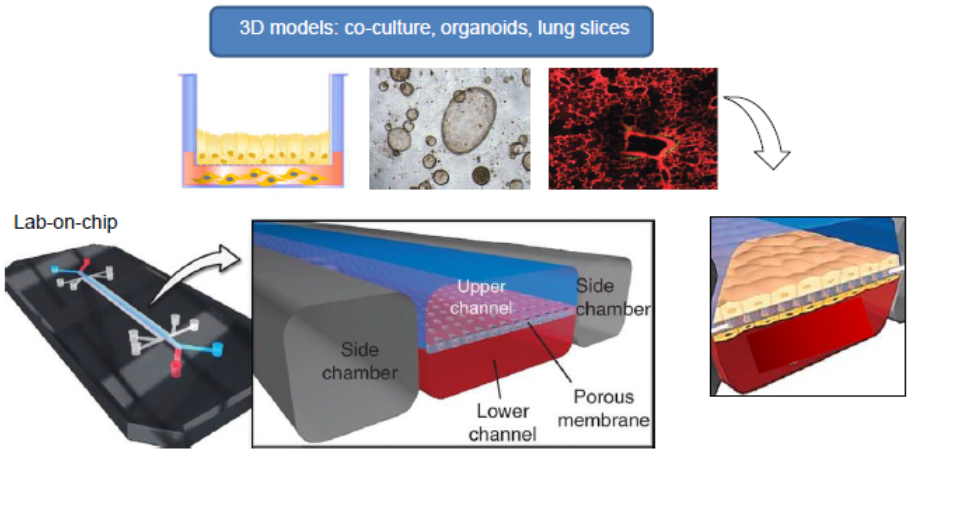Work package 3
Setting up novel 3D lab-on-a-chip culture models for tissue damage and repair
The information on genes and pathways involved in aberrant tissue damage and repair responses in lung disease obtained in WP2 can be validated, extended, and mechanistically tested using in vitro models in our search for novel, personalized drug targets. However, existing in vitro models do not fully represent the complexity of the lung and development of more advanced in vitro models is needed.
The progenitor cells responsible for lung tissue regeneration reside within their local microenvironment, the niche, composed of both structural elements (extracellular matrix) and supporting stromal cells, that normally regulate adequate activation and differentiation of progenitor cell populations. Damage to the microenvironment may impair the regenerative capacity of progenitor cells in lung disease. Lung repair involves local and systemic communication between several cell types and the extracellular matrix, explaining the need for complex 3-dimensional cell and tissue models that recapitulate the local complexity of the lung, and the capacity of intercellular communication by the lung epithelium. In addition to mimicking the 3D microenvironment, these models should allow for well-controlled, temporally varying pharmacological intervention.
In this way, these models will enable us to gain insight in abnormal damage and repair responses in lung disease and to test novel therapeutic strategies.
The first aim of this work package is to transfer established co-culture models of air-liquid interface (ALI)-differentiated airway epithelial cells and mesenchymal stromal cells and/or alveolar organoids (including 3D matrix environment) into dynamic lab-on-chip systems, with the possibility to add additional locally and systemically relevant cell types, e.g. endothelial cells, immune cells (local) and skeletal myocytes (systemic). Hereto, we will use cell lines (16HBE, Calu-3, A549, MRC-5) as well as primary airway and distal lung epithelial and stromal cells. Primary cells will be obtained from bronchial brushings and lung tissue derived from lung transplantation or resection surgery. The skeletal muscle compartment for co-cultures will be established from well-characterized muscle progenitor cell lines, or primary muscle satellite cells. Lab-on-chip systems will allow for real-time monitoring of secretion profiles of cytokine, growth factor and metabolic responses in the different models.
The second aim is to optimize the use of precision-cut lung slice cultures from lung tissue of animal models and human lung tissue (COPD patients and controls), and culture these in chip devices. Currently, precision-cut lung slices can be kept in culture for a limited time. To increase the feasibility of this model for mechanistic studies of lung repair, there is an urgent need to optimize culture conditions to prolong the ex vivo viability of the tissue.
The third aim is to use the optimized 3D models with the lab-on-a-chip technology for real-time monitoring to provide insight in the optimal timeframe to study repair responses upon different environmental exposures, including cigarette smoke extract (CSE), air pollutants (e.g. particulate matter, diesel exhaust) and occupational exposures (as identified in WP1). The development of in situ metabolite analysis in lab-chips and possible coupling of lab-chip to other analytical technology like mass spectrometry will be explored to realize advanced mechanistic studies. This will allow unraveling of the kinetics of repair responses and identification of specific damage and repair phase-dependent metabolic and cellular signals.
The deliverable of this working package are advanced models to study damage and repair in chronic lung disease and signals that could potentially serve as early markers for lung damage. These signals may later be assessed in the PRIL cohort (WP6) and the models will be used to assess the involvement of identified biomarkers of the PRIL cohort (WP4-8) in abnormal damage and repair responses in lung disease and to evaluate their use as therapeutic target (WP10 & 11).
 Figure 5 Schematic of lab-on-a-chip using 3D lung tissue models.
Figure 5 Schematic of lab-on-a-chip using 3D lung tissue models.
